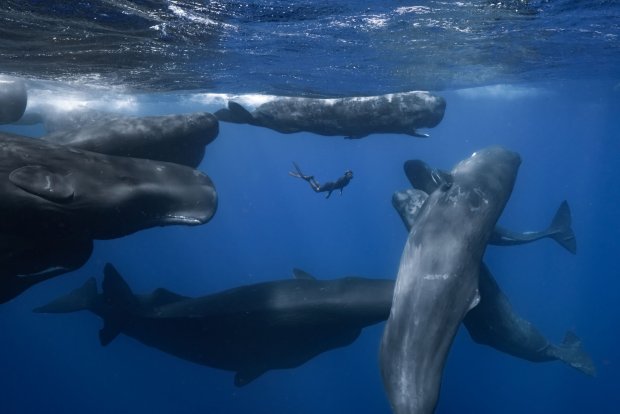“There really is this extraterrestrial quality to sperm whales,” says Patrick Dykstra, a cinematographer with a fascination for underwater sea life. His interest in whales — and his interactions with them — are captured in the latest installment of the PBS series “Nature.”
“Patrick and the Whale” has an appealing, low-key sensibility that’s missing from similar but more frantic programming from NatGeo, which is too often filled with hokey, intrusive music and hyperbolic hosts. Director Mark Fletcher avoids those faux theatrics and the episode’s meditative qualities are reflective of the team’s quiet deference to the sperm whales they encounter.
Even so, “Patrick and the Whale” lacks shape and purpose, and would benefit from probing scientific insights into the species. Instead, it tends to come off like a tax write-off for Dykstra’s sincere interest and enthusiastic travels, rather than an enlightening documentary.
Humans have only been able to observe whales when they’re near the water’s surface. So most of the program’s drama comes down to whether Dykskra can attach a camera to one of the whales in the hopes of learning what they do when swimming around at the ocean’s lowest depths.
Dykstra says this is one way they can help with preservation efforts, but he doesn’t explain how this footage would aid in that. Why are whale populations dwindling? Are they being hunted? Is climate crisis a factor? Pollution? Dykstra doesn’t say, nor does the program interview marine biologists to elaborate further.
The underwater photography can be mesmerizing at times, strangely inert at others. “Patrick and the Whale” is most compelling when Dykstra describes the different social dynamics he has observed over the years. Blue whales near Sri Lanka “are so big, they don’t have time to socialize, at least not with humans. They barely do it with each other.” Off the coast of Dominica in the Caribbean Sea, though, he’s found a population of sperm whales that is more social “than almost any other in the world.”
Sperm whales weigh somewhere around 30,000 pounds, are several times the length of a person, and their brains are larger than any other animal’s brain on Earth. “What are they thinking?” Dykstra wonders. It’s impossible to know and, to his credit, Dykstra doesn’t make any wild, anthropomorphic speculations. He encounters a whale he names Dolores. “Just on a whim, I knocked on the side of my camera housing: tick-tick, tick-tick-tick.” The clicks imitate the sounds sperm whales make. “And immediately, she stopped completely and turned to face me. She was so interested and so curious.” They hang out vertically for a bit before Dolores swims off.
“She quickly became the whale that I wanted to see the most. I was worried I wouldn’t find her. But then she found me.” His instinct is to not touch any marine life, but Dolores “wasn’t having any of that,” he says, “she just completely lifted me out of the water on her face.”
What are we to make of these encounters? They are clearly meaningful to him, but anticlimactic for the viewer because Dykstra is unable to extrapolate a larger significance.
At its best, nature programming offers a window into how other species live and interact with the world around them. What are their needs? What are their struggles? What are they like? Documentaries about meerkats or elephants are able to show us how their daily lives unfold. That’s a harder task when filming sperm whales, which do not express emotion or intention in ways that are easily legible.
There’s nothing wrong with documenting one’s adventures. But in order to be worthwhile, projects like “Patrick and the Whale” need more rigor and a sturdier reason for being.
“Nature: Patrick and the Whale” — 2.5 stars (out of 4)
Where to watch: 7 p.m. Wednesday on PBS
Nina Metz is a Tribune critic.




